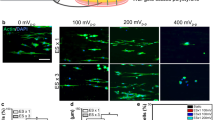Abstract
50 μm tungsten microneedles have been used as a means to introduce longitudinal intra-fascicular electrodes (LIFE) into small peripheral nerve fascicles. However, recent attempts to implant LIFEs into larger, human sized nerves with the same needles resulted in buckling failure of the introducer needle. In the present study, the implantation mechanics (penetration forces and penetration dimple depth) of electrosharpened tungsten microneedles ranging in diameters from 50 to 200 μm into freshly excised porcine peripheral nerve trunks between 3 and 5 mm in thickness was characterized to understand the implantation mechanics and to find the minimum needle diameter that would result in successful penetration. The implant success rate was found to be highest with needles having diameters between 80 and 120 μm. The force of successful penetration ranged from 7.2 ± 0.6 to 71.8 ± 19.5 mN, and increased monotonically with needle diameter. It also had a tendency to increase with increasing tip angles. The dimple depth for successful penetrations varied between 1 and 1.5 mm, and also tended to increase with increasing tip angles, although it was generally not affected by increased needle diameter. Only the smallest penetration dimple depth was found to be different from the others and was associated with the smallest diameter needle (50 μm). Analysis based on the critical buckling force and the measured implantation forces indicated a 15 mm long needle of 80 μm diameter would be necessary and sufficient to penetrate medium to large sized nerves.







Similar content being viewed by others
References
Andreasen LN (2002) The nerve cuff electrode and cutaneous sensory feedback. Ph.D. dissertation, Center for Sensory–Motor Interaction, Aalborg University, Aalborg, pp 16–27
Beer FP, Johnston ER, DeWolf JT (2002) Mechanics of materials, 3rd edn, chapter 11. McGraw-Hill, London
Citi L, Micera S, Carpaneto J, Yoshida K, Hoffmann KP, Koch KP, Dario P (2006) Characterization of tLIFE neural response for the control of a cybernetic hand. In: Proceedings of the BioRob2006, Pisa
Dhillon GS, Horch KW (2005) Direct neural sensory feedback and control of a prosthetic arm. IEEE Trans Neural Syst Rehabil Eng 13(4):468–472
Dhillon GS, Lawrence SM, Hutchinson DT, Horch KW (2004) Residual function in peripheral nerve stumps of amputees: implications for neural control of artificial limbs. J Hand Surg Am 29(4):605–615
Dhillon GS, Kruger TB, Sandhu JS, Horch KW (2005) Effects of short-term training on sensory and motor function in severed nerves of long-term human amputees. J Neurophysiol 93(5):2625–2633
Fried K, Frisen J, Mozart M (1989) De- and regeneration of axons after minor lesions in the rat sciatic nerve. Effects of microneurography electrode penetrations. Pain 36(1):93–102
Jensen W, Yoshida K, Malina T, Hofmann UG (2001) Measurement of intrafascicular insertion force of a tungsten needle into peripheral nerve. 23rd Ann. Int. Conf. of the IEEE-EMBS, Istanbul
Jensen W, Hofmann UG, Yoshida K (2003) Assessment of subdural insertion force of single-tine microelectrodes in rat cerebral cortex. In: Proceedings of the international conference of the IEEE-EMBS 25:2168–2171, Cancun
Jensen W, Yoshida K, Hofmann UG (2006) In-vivo implant mechanics of flexible, silicon-based ACREO microelectrode arrays in rat cerebral cortex. IEEE Trans Biomed Eng 53 (5):934–940
King R (1999) Atlas of peripheral nerve pathology. Oxford University Press, New York, pp 1–20
Lago, N, Yoshida, K, Koch, KP, Navarro, X (2006) Assessment of biocompatibility of chronically implanted polyimide and platinum intrafascicular electrodes. IEEE Trans Biomed Eng 54(2):281–290
Lefurge T, Goodall E, Horch K, Stensaas L, Schoenberg A (1991) Chronically implanted intrafascicular recording electrodes. Ann Biomed Eng 19(2):197–207
Lontis, ER (2005) Mechanisms of stimulation in magnetic stimulation of nervous tissue. Ph.D. Dissertation, Center for Sensory–Motor Interaction, Aalborg University, Aalborg
Nystrom B, Hagbarth KE (1981) Microelectrode recordings from transected nerves in amputees with phantom limb pain. Neurosci Lett 27(2):211–216
Ochoa JL, Campero M, Serra J, Bostock H (2005) Hyperexcitable polymodal and insensitive nociceptors in painful human neuropathy. Muscle Nerve 32(4):459–472
Rice AS, Andreev NY, McMahon SB (1994) The consequences of microneurography electrode-induced injury of peripheral nerves observed in the rat and man. Pain 59(3):385–393
Sunderland S, Bradley KC (1961) Stress–strain phenomena in human peripheral nerve trunks. Brain 84:102–119
Sunderland S (1978) Nerves and nerve injuries, 2nd ed. Churchill Livingstone, Edinburgh
Vallbo AB, Hagbarth KE (1968) Activity from skin mechanoreceptors recorded percutaneously in awake human subjects. Exp Neurol 21(3):270–289
Yoshida K, Stein RB (1999) Characterization of signals and noise rejection with bipolar longitudinal intrafascicular electrodes. IEEE Trans Biomed Eng 46(2):226–234
Yoshida K, Jovanovic K, Stein RB (2000) Intrafascicular electrodes for stimulation and recording from mudpuppy spinal roots. J Neurosci Methods 96(1):47–55
Acknowledgments
The authors would like to thank Brynjar Vatnsdal Pálsson, Ingólfur Pálsson, Drs. Romulus Lontis and Winnie Jensen for their assistance during the experiments and the preparation of the paper. The authors would further like to thank the Biolab at Aarhus University-Aalborg and the Animal Laboratory at Skejby Hospital for supplying the nerves used in this study, and Robin Waldron for grammatical editing of the paper. This work was supported in part by an award from the Sygekassernes Helsefond, and was performed as part of the Cyberhand project (European Commission 5th framework programme, IST-2001-35094 Cyberhand).
Author information
Authors and Affiliations
Corresponding author
Rights and permissions
About this article
Cite this article
Yoshida, K., Lewinsky, I., Nielsen, M. et al. Implantation mechanics of tungsten microneedles into peripheral nerve trunks. Med Bio Eng Comput 45, 413–420 (2007). https://doi.org/10.1007/s11517-007-0175-0
Received:
Accepted:
Published:
Issue Date:
DOI: https://doi.org/10.1007/s11517-007-0175-0




